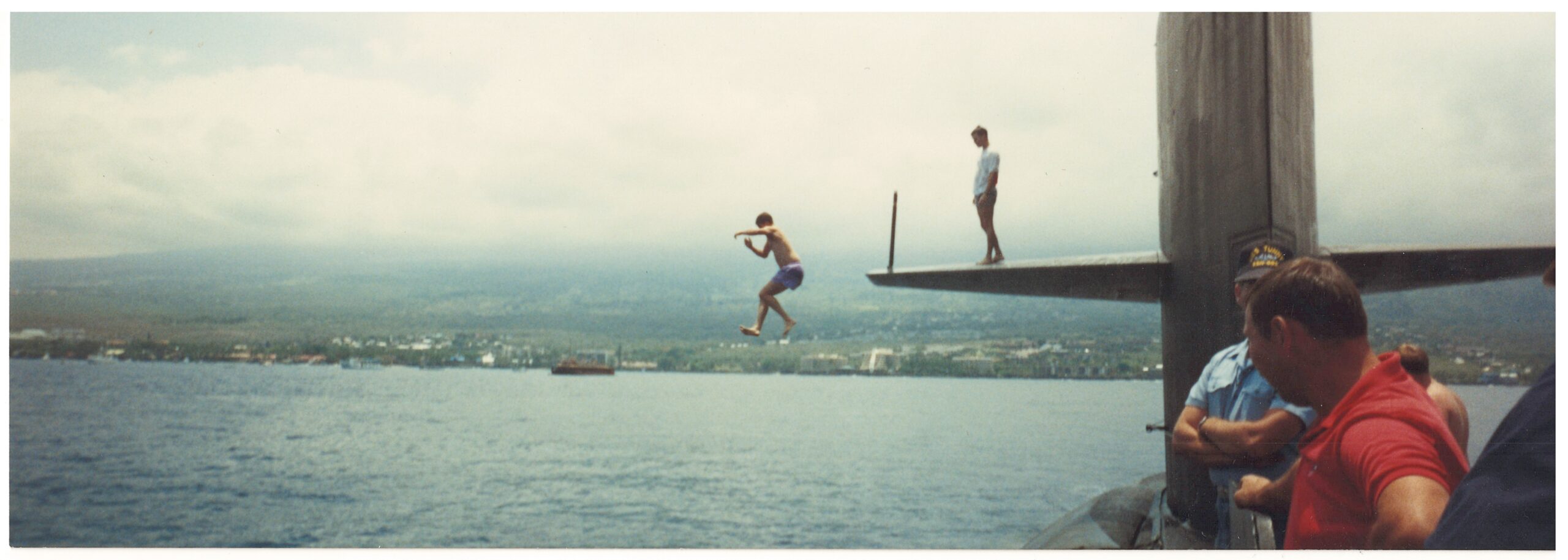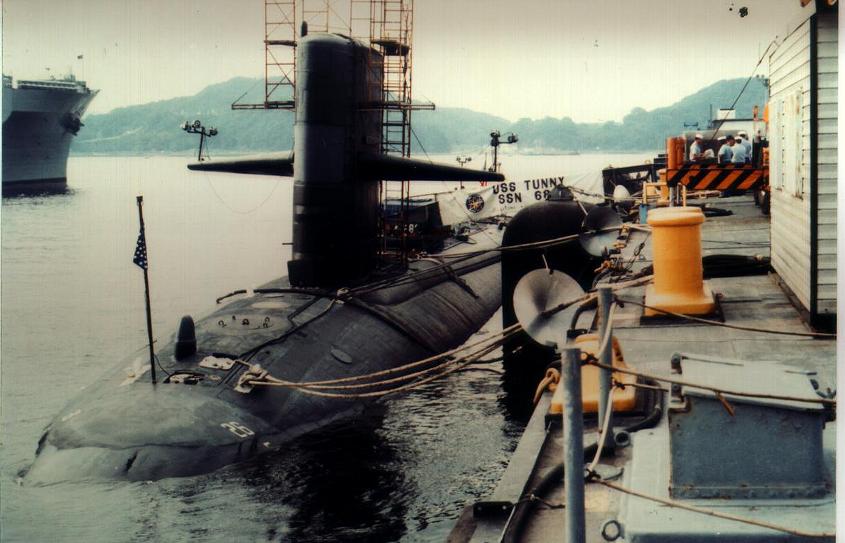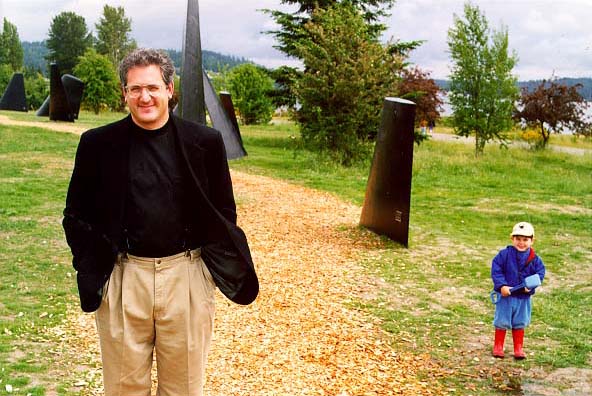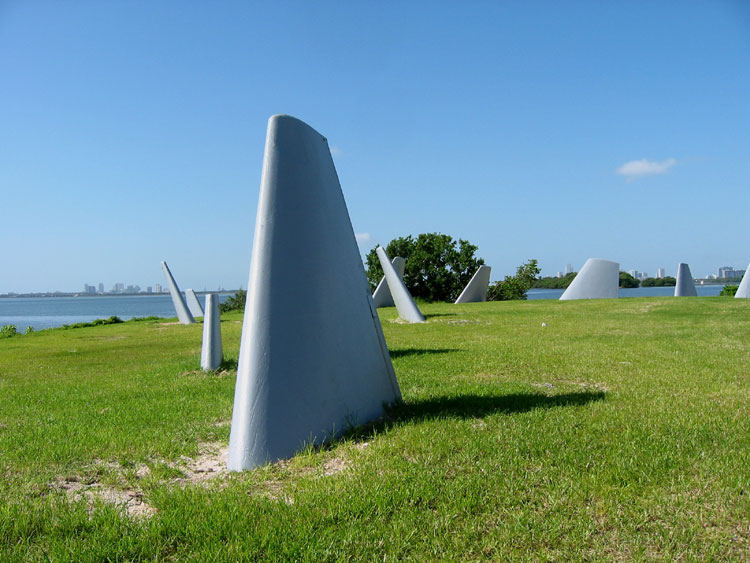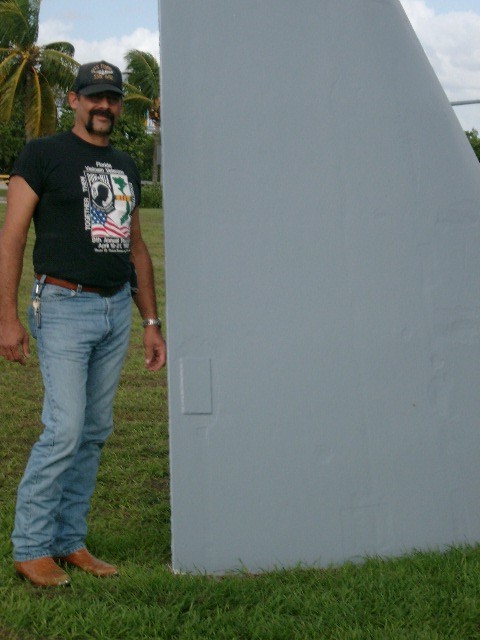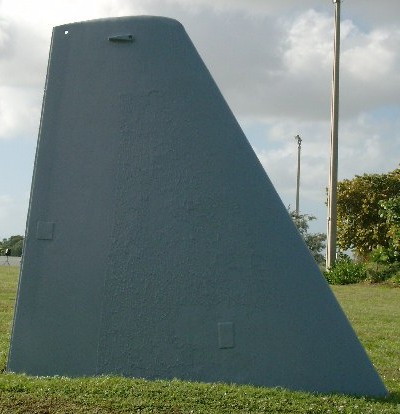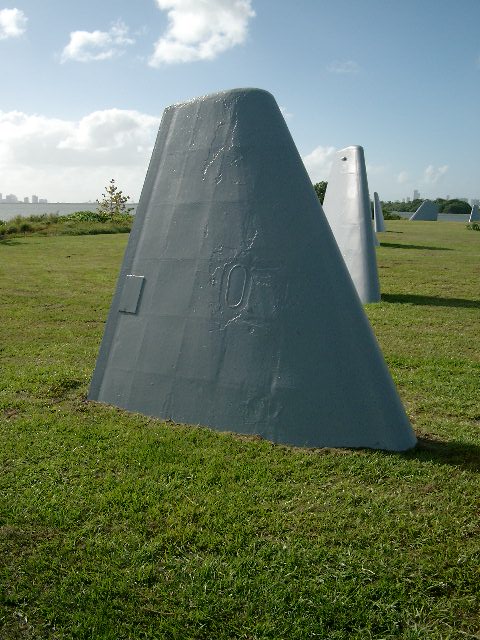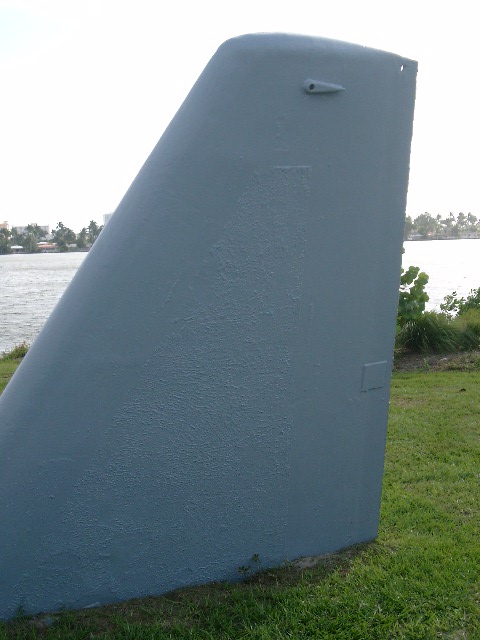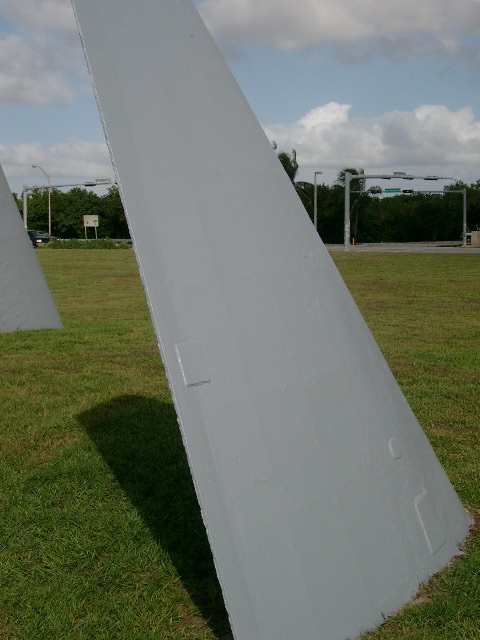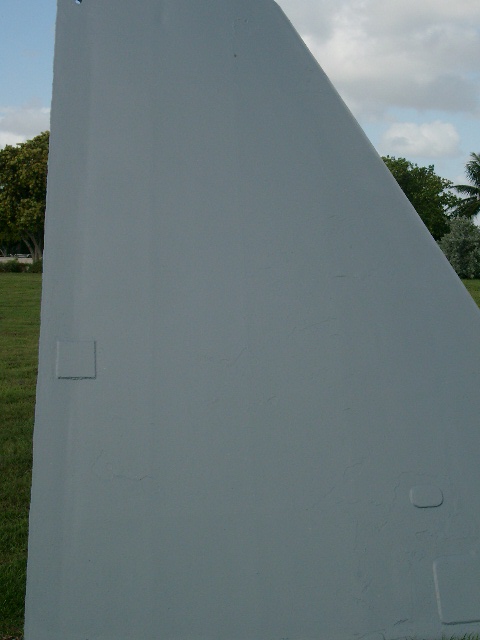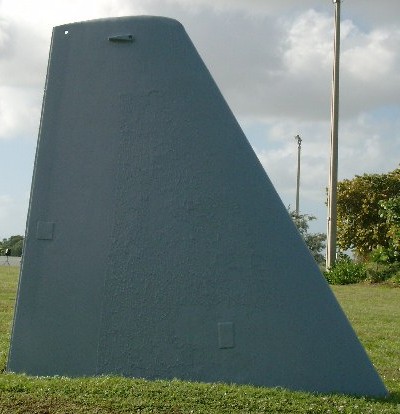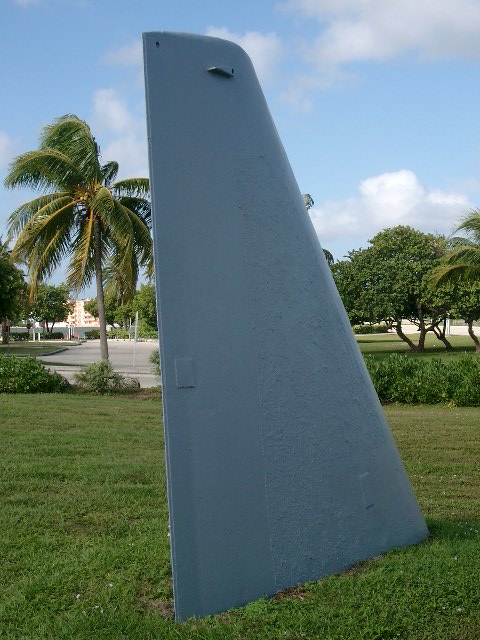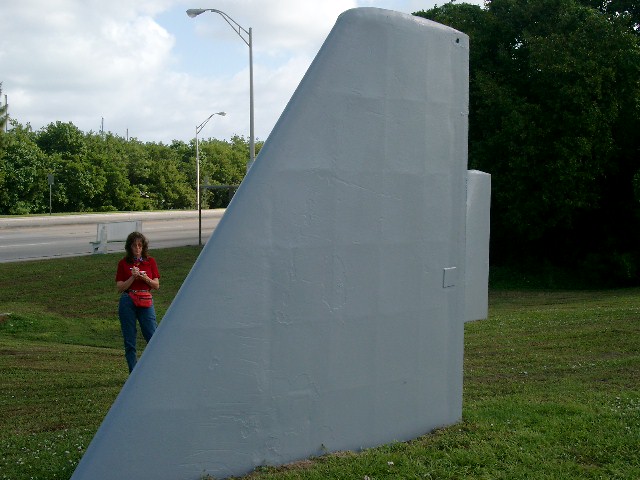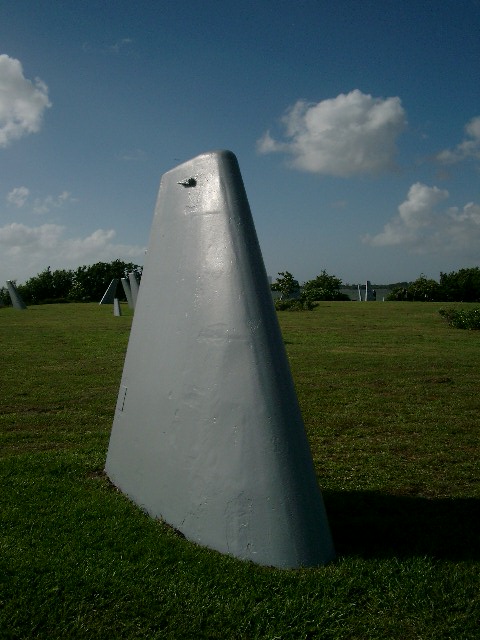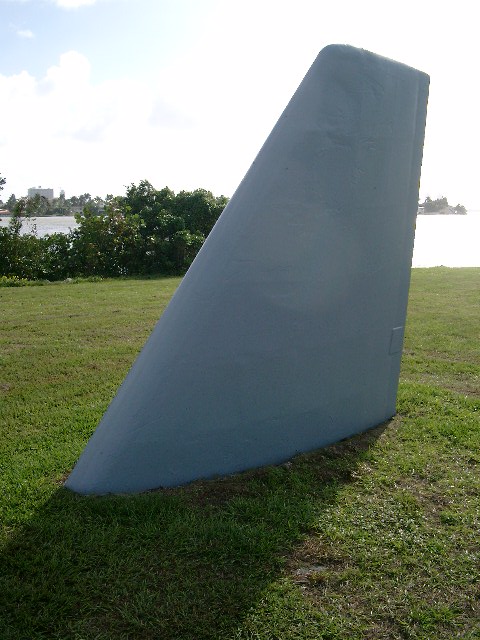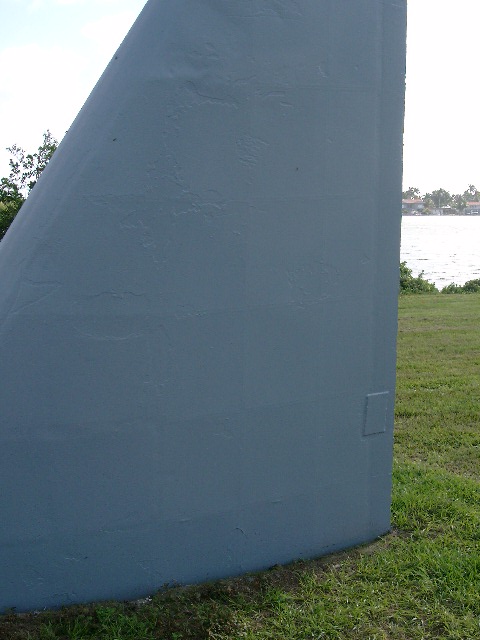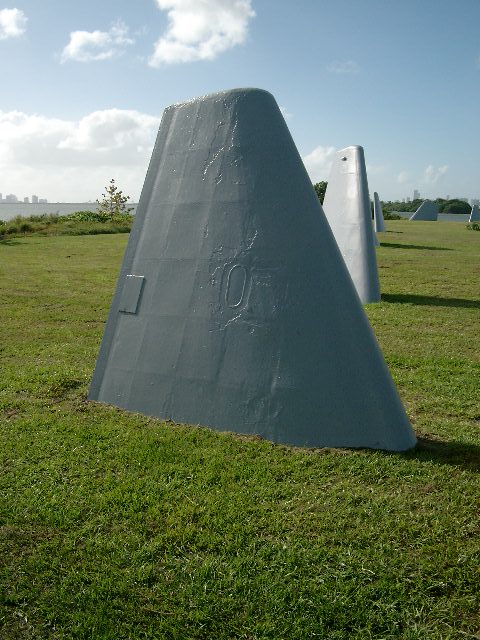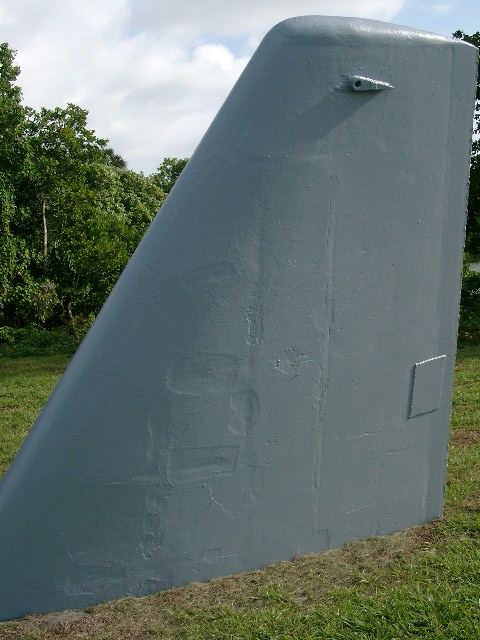All about the Fairwater planes
Despite the Navy’s desire to melt my boat down into scrap, and sell it to the John Deere company (it’s true) to make tractors and stuff, there was a small and interesting problem… It is impractical for the Navy to recycle the Fairwater planes, also called the “Sail Planes”. This is due to the contruction of these devices… Unlike the pressure hull, the planes were filled with a material to harden them. Presumably, this is for the harsh duty they would endure breaking through the ice, I’m not sure. But, the planes were filled with a material that becomes solid and hard, and adds strength, and this material makes it impossible to boil the planes down for recycling. So, the planes are spared that humiliation.
Then one day John Young (civilian, Professor of Sculpture at University of Washington) discusses the possibility of acquiring some steel from the Puget Sound Naval Shipyard in Bremerton, WA. Basically, PSNS offered him the sail planes – perhaps he could recover the steel or materials somehow for use by his students in art projects. PSNS offers to give John “as many Sturgeon class boat sail planes as he can use.” (Maybe they were piling up, since they can’t be recycled, and there were so many boats being scrapped at PSNS at the time). John is impressed and declines to strip away steel from the sail planes, he thinks they would be fantastic, just like they are.
Here is the story of TUNNY’s Sail Planes.
Me and the Sail planes
I can tell you from personal experience that I HATED installing the security lights. You had to put a dirty, heavy safety harness over your sweaty, tucked in uniform and it pulled every direction as you walk out to the edge of the sail plane, hang over and have somebody throw the gear up to you (or swing the cords up and you catch them then pull the gear up one piece at a time). THEN you gotta walk out to the edge of the plane and set it all up nice. Repeat for each side. On most boats this work was done by the IC Div (Interior Communications). On TUNNY – when I was onboard – it fell to E Div, for the same reason as E Div was assigned the electrical responsibility of the Oxygen Generator. Don’t get me started. It seems like I was always the guy to put up the security lights, and it was unpleasant.
The point I am trying to make is my close, personal relationship with TUNNY’s sail planes. I have jumped from them, dived from them at swim call, and taken baby steps to walk across them with a dirty harness and security lights. Me and the sail planes, we go way back.
You will be glad to know that the sail planes escaped recycling.
Here is something you weren’t expecting: 682 TUNNY’s sail planes are part of an art exhibit in Miami.
Meet John Young
I’ll just copy this in from his web site.. It describes the exhibits he has – One in Seattle, and a new one in Miami.:
This work is an environmentally scaled sculpture created using the actual diving-plane fins from decommissioned United States Navy attack submarines built in the 1960s. The fins are arranged to simulate the dorsal fins of a large Orca whale pod or a school of salmon. This artwork represents the ultimate in recycling….”From Swords into Plowshares”.
The artwork uses 22 fins placed at various angles and heights (ranging from four feet to twelve feet), and traverse about 500 feet in length. The work is located in Magnuson Park at Sand Point in Seattle. Magnuson Park has particular resonance as a site due to the former U.S. Navy Base at Sand Point which recently became a Seattle Park. Sited there, the artwork serves as a positive historic monument of the Navy’s involvement on the site. This artwork is also one of the first memorials in the United States to honor those men and women who served our country during the Cold War.
The fins are composed of high tensile steel and are used intact. Since they are virtually indestructible (they were designed to withstand depth charge attacks!), they are maintenance free. They are completely safe and inert; in other words, they are completely devoid of radioactivity or toxic substances. All the fins are structurally supported by hidden, reinforced concrete footings buried below grade. These footings were designed by the late John Skilling, Seattle’s most renowned structural engineer, to ensure the safety of the work and the public.
The work seems to have widespread appeal. For those that appreciate the Navy and submarines, this work is creating a submarine fin park. For those that appreciate whales, it is an artwork about them. For others, it speaks to the idea of turning the ultimate warships- nuclear submarines- into Art. It represents an extremely important period in American history, the Cold War, and symbolically signifies an end to that era. And it is a grand form of recycling in an ecologically sound way. It also represents a significant amount of the national deficit being returned to the people for their enjoyment and appreciation. Beyond all of that, the forms are strong, minimal shapes which create a powerful environmental sculptural experience. There are many positive meanings and layers to this work.
Contributors to the creation of this work also represent a unique and possibly historic collaboration. In addition to the artist, the following were key collaborators and comprised the organizational team in the execution of this work: The United States Navy and the Puget Sound Naval Shipyard provided the fins; Mr. Bryan Zetlen, President of Seattle Scientific and liason with the U.S. Navy; Mr. Max Gurvich, renowned philanthropist and art supporter, producer and fund-raiser; and Mr. Louis Treiger, legal counsel for our non-profit 501(c)3 corporation, entitled The Swords Into Plowshares Project Corporation.
Thanks to the generous efforts of the Navy, these gentlemen, the Seattle Arts Commission, the Seattle Department of Parks and Recreation, and the numerous private donors, this artwork was donated fully installed as a gift to the City of Seattle, costing the City and taxpayers absolutely nothing.
The opening dedication on Memorial Day, May 25, 1998, was attended by Mayor of Seattle Paul Schell, Washington State Senator Ken Jacobsen, Admiral Paul Sullivan and Admiral William Center, United States Navy, Gemini and Apollo 12 astronaut Richard Gordon, and numerous city officials, patrons of the arts and public. In addition, United States Congressman Norm Dicks sent a letter of support earlier in the year.
The hope is that similar “pods” will be created around the country and the world, as symbols for peace on a global scale. The artist is particularly interested in creating them in Russia near the former Soviet submarine bases in Vladivostock or St. Petersburg, in the desert of the American Southwest, along the coast of Southern California, and on the East Coast.
For more information please contact the artist:
John T. Young
Professor of Sculpture
University of Washington
Seattle, WA. 98195
Tel. 206 543-0997 or 206 417-9560
e-mail: jtyoung@u.washington.edu
The Swords Into Plowshares Project
A Non-Profit Corporation
13700 42nd Place N.E.
Seattle, Washington 98125-3830 U.S.A.
Tel./FAX: 206 417-9560
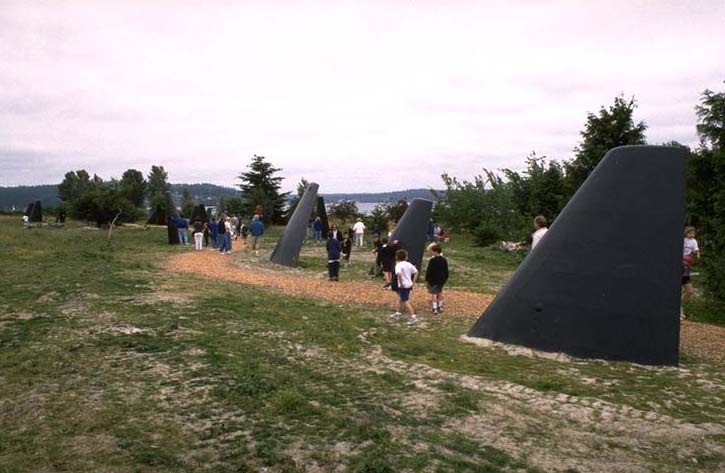
Miami installation information:
September 2002
MONUMENT TO WORLD PEACE COMPLETED IN MIAMI-DADE COUNTY
A public art monument that expresses the hope of world peace is located in the Miami area. The work is designed by artist John T. Young, and creates the image of a giant school of wild dolphins by using fins from decommissioned warships donated by the United States Navy. The work conveys the ancient biblical message, “Turn your Swords into Plowshares”, and simultaneously pays tribute to the role our nation’s armed forces play in preserving and defending world peace. The work was approved by Miami-Dade County Parks Department and the Miami-Dade County Art in Public Places Commission, and is located in Pelican Harbor Park in North Bay Village, a dramatic waterfront park between Miami and Miami Beach.
The Fin Project: From Swords Into Plowshares is an international project. The work is about turning former nuclear weapons into Art, recycling, and marking an end to war. The first version was successfully completed in Magnuson Park in Seattle, using twenty-two diving plane fins from Cold War era nuclear submarines over a span of 500 feet. In addition to South Florida, versions are being proposed for other strategic locations around the globe, including a coastal city in Russia. The Russian installation will hopefully employ a dozen fins from decommissioned U.S. Navy subs as well as a dozen fins from former Soviet subs mixed together, creating the ultimate statement of international peace, cooperation, and the end of the Cold War.
The work has widespread appeal to diverse groups including naturalists and dolphin/whale watchers, supporters of the U.S. armed forces, especially the Navy and its submariners, as well as the art world. The Fin Project: From Swords Into Plowshares turns the ultimate warships of the modern age — nuclear submarines — into Art. It is a memorial that honors the contributions of the servicemen and women during recent poignant times in American history. It also represents a significant amount of the national deficit being returned to the people for their enjoyment and appreciation. The forms are strong, minimal shapes that create a powerful environmental sculptural experience with many positive meanings and layers.
The most important part of the project -the submarine diving plane fins- were donated by the United States Navy. Two dozen fins, each weighing 10,000 lbs. and valued at $25,000, were donated, a total value of approximately $600,000.00. (The fins are completely devoid of toxic substances and radioactivity.) It is necessary to raise the funding to cover the installation costs, approximately $350,000. This includes transportation of the fins from the Puget Sound Naval Shipyard in Bremerton, WA. to Florida (three fins per flatbed truck), crane, excavation, concrete footings, welding, surface prep and painting, plaques, lighting, crew labor and artist’s fee. Consequently, the total value of the artwork is conservatively estimated at $950,000.00.
It is the intention of the Swords Into Plowshares Project Corporation (a Non-Profit 501(c )3 Corporation) to donate the finished projects to the selected parks as gifts to the public. Donors are actively being sought for this global project. All donations are completely tax deductible and donors’ names will appear on the entry plaque to the project.
This is an extraordinary opportunity to expand ideas of world peace, recycling and the end of war in a dynamic configuration that directly relates to the natural history and environment of the Florida coast. Anyone interested in making a private or corporate donation to this significant monument for world peace should contact the artist, John T. Young.
Inquiries should be directed to the artist: John T. Young Tel. 206-417-9560
or via email: jtyoung@u.washington.edu
Fairwater planes from the following decommissioned United States submarines are included in the Seattle and Miami installations:
Seattle Fins: SSN 669 Seahorse, SSBN 641 Simon Bolivar, SSN 652 Puffer, SSN 615 Gato, SSBN 620 John Adams, SSN 595 Plunger, SSN 638 Whale, SSN 667 Bergall, SSN 673 Flying Fish, SSN 597 Tullibee, SSN 650 Pargo, SSN 662 Gurnard.
Miami Fins: Sea Devil SSN 664, Pogy SSN 647, Sand Lance SSN 660, Pintado SSN 672, Trepang SSN 674, Billfish SSN 676, Archerfish SSN 678, Tunny SSN 682, Von Steuben SSBN 632, Sculpin SSN 590, Cavalla SSN 684.
Miami Exhibit
Like the article says, he already HAS set up 24 sail planes in Seattle. If you get a chance to go there, send me some pictures.
Now let’s talk about the Miami exhibit, which includes TUNNY.
Intially, I had mixed feelings about this. It seemed disrespectful to one of America’s Guardians to rip away a part of her and wedge it into the ground in an un-natural position. But then I thought about the day when I can take my kids to Miami and they can touch this thing and that’s all we have left, I guess I am glad it isn’t a square block of recycled steel, no longer submarine shaped at all.
There are more Miami photos from his web site like this one: But I don’t know (yet) which one is TUNNY’s.
After several missed calls, I finally spoke with Mr. Young. He was great about answering my questions. I did my usual fumbling-around-thing, looking for ideas, trying to get the relevant facts for our web site. I’m not much a of a reporter… I wasn’t very prepared with a list of questions. What I really had was a huge amount of awe for this project and enthusiasm for everything TUNNY. Which I think he understood.
Mr. Young is the founder and the artist for “The Swords Into Plowshares Project”, a Non-Profit Corporation. For the rest of this description, I’ll refer to this organization as SIPP (an acronym for Swords Into Plowshares Project).
My most urgent question was, “When the site will be dedicated?”. He replied that there is still alot of communication between SIPP and the Miami Parks Department. Therefore, the dedication date is likely to be Memorial Day (May 26, 2003), or soon after. At this time the date has not been finalized. When the dedication date is known, Mr. Young offered to call and keep me informed. I’ll pass that information on to our crew here.
I asked about TUNNY’s sail planes. What does it take to get your name on a plaque? What are ways that individuals can assist with SIPP? Here are his responses:
Tom: How do I get my name on TUNNY’s sail plane plaque?
John: There are no plaques on fins in Miami “yet”. Presently, there are no donors to support like the park in Seattle. SIPP would love to sell plaques for Miami, but this is not completely decided right now. For example, in Seattle, each fin was sponsored by a donor.
Tom: How much would it cost to sponsor one?
John: Each Seattle donor paid $ 7,500 to sponsor a fin.
Tom: That’s alot of money to me!
John: That’s seems to be a common response these days. Fundraising seemed easier for the Seatttle installation than the Miami installation for two reasons: One the economy was in better condition back then. Secondly, there were large corporations in the Seattle area that were responsive to donation requests.
Tom: But if the exhibit is installed wihout any taxpayer funds, how are you completing the work in Miami?
John: In Miami, SIPP couldn’t raise the amount of money from donors, so SIPP sponsored the Miami installation. However, we still owe the contractor alot of money. We are over $40,000 in debt right now.
Tom: Is there any way I can get my name on the TUNNY fins without paying $ 7500?
John: In both cities there is a main entry plaque, and donors of $1000 or more would get name on Park Main Entry Plaque.
Tom: but nothing on TUNNY’s fins…
John: The Miami exhibit lists boat names on the entry plaque, but not on individual fins. If any vets know of Corporations (such as defense related) or any Corporation interested in making a tax deductible decution, then please have them contact me. We want to include more corporate sponsors on the Main Entry Plaque. There are no plaques at all any individual fin, but there may be eventually.
Tom: Do you have a layout plan for the Site, and can we identify TUNNY’s locations?
John: I have a layout map of the site, but I cannot identify individual sail planes for you. The Navy told me which submarines fins were donated, but did not identify individual pieces for each boat. I can tell you with assurance that both of TUNNY’s planes are included in the Miami exhibit. But I couldn’t tell you which (2) belong to TUNNY. In fact, that is probably something you could tell me.
Tom: What do you mean?
John: Well, if you are familiar with TUNNY’s fairwater planes, then you are probably one of the few people that could help identify which of the planes belonged to TUNNY.
Tom: Aren’t they all the same?
John: Oh, no, not at all. They are quite individual. Each is very different, but they are not marked which belongs to each specific boat. Instead, there are subtle differences in shape and size, the fittings are different; some have threaded fittings and others are raised (little cones). Some have fiberglass tips, and many have welded patches. Each one is unique.
Tom: Well, I am familiar with the threaded type for TUNNY because that’s where I installed the security lights inport. I remember how big that hole was, where it was located. I don’t think we had any fiberglass tips.
John: Even the threaded hole sizes are different between boats. If you didn’t have fiberglass tips on the planes, then that eliminates about half of them right away. the location of the holes is different between boats… Maybe you could tell.
Tom: Maybe I could. I’ll let you know if I ever get out there. Any message from you for TUNNY’s crew? I can pass a message along on the TUNNY web page…
John: My main message is to find help paying the contractor bills. Also, the Miami park location: 79th Street JFK Causeway. Finally, please thank the guys from the boat. I appreciate the efforts of all American submarine crews during the Cold War, who stood in the way of the Soviet Union during a very volatile 50 years. It is an honor for me to be able to use these materials and express my appreciation for that effort.
I mailed John a TUNNY hat.. he said he doesn’t have a boat hat, but would like one.
Finding TUNNY’s planes
This concept is a little complicated: Because PSNS didn’t identify the individual planes, we don’t know which planes belong to TUNNY. There are a total of 22 planes displayed, and certainly two of them are TUNNY’s. But your guess is as good as any, which ones belong to TUNNY?
If you are planning to visit the Park in Miami, I hope you’ll take the time to play this cool game, “Hunt for TUNNY’s Fairwater Planes”.
Hunt for TUNNY’s Fairwawater Planes
An “outdoor submarine game” for adults and children, Ages 3 and Up
What you’ll need:
- Familiarity with the TUNNY’s Fairwater planes
- Eyeballs
- Park Map
- (22) Profile sheets (print this and make 22 copies)
- Pencil
How to Play: Using your Profile sheets and Eyeballs, make notes about all the visual characteristics of the displayed Fairwater Planes in the park. Compare your observations with things you remember about TUNNY and submit your remarks.
Every Plane will be different. For example, some planes will have many weld marks and patches. Also, the fittings for the security lights are different, some have cones for support, and some don’t.
Click on these images to see a great big version with better details.
SECURITY LIGHT – This is an example of a plane with a “cone” surrounding the Security Light threaded hole
Detailed Game Play:
1. Print out the Park Map
2. Print out (22) Profile Sheets
3. Drive to Miami and find the Pelican Harbor Park (here is a map). it’s on the NE 79th Street Causeway.
4. START at the Park’s entrance, there is a plaque.
5. Look at the Map and find each corresponding Plane’s “Profile Sheet”.
6. For every displayed Fairwater Plane, mark up your profile sheet, showing physical characteristics. You can use the “Clues” from the Profile Sheet to get you started.
7. Write down what you remember about the Fairwater Planes on the profile sheets. Explain what you remember completely.
8. Throw it all in an envelope and send your profile sheets to the TUNNY Homepage: 904 Delrey drive, College Station, Texas 77845
I hope that – over time – several people will submit profile sheets and we will start to see a pattern. Eventually we should be able to identify which ones are “probably” from TUNNY.
Hints
1. There are 22 planes total.
2. Four of the planes are not Sturgeon-Class boats. These planes are from the Von Steuben (SSBN 632) and Sculpin (SSN 590).
3. Many planes have “cones” around the Security Lights fitting (see example picture). TUNNY did not have these cones.
4. Many of the planes have patches and welding scars, from repairs. (see picture) (CDR Donovan, former Engineering Officer, says TUNNY had several of these.)
5. The planes have variations for the security light threaded fitting. Specifically, size of the fitting varies, and distance from the plane edge varies. Some have “no ftting” at all. TUNNY had a fitting, about a 1″ diameter hole.
6. Many of the planes had fiberglass “tips” on the edge of the plane. I think TUNNY did “not” have these. (Could someone please confirm)
You be the judge
John Rosaci visited the SIPP Miami exhibit. He attended the dedication ceremony, met with John Young (the artist for the exhibit) and Don Simmons (coordinator for the materials at PSNS). Most importantly, John Rosaci has done some impressive research detective work in the park, to help identify TUNNY’s planes. Here are the facts and assumptions… please read them and drop me a line if you agree or think we’ve gotten some of this wrong….
1. Almost every plane in the park has a cylinderical “cone” surrounding the security lights hole. There are only 4 planes (2 sets) that don’t have a cone. These 4 planes have a teardrop shape for the security lights. (Tom Jordan comment: I believe TUNNY’s planes had the teardrop shape. This is also consistent with some of the photos on the Ship’s Pictures page).
2. Every plane in the park has a patch in the aft, center. This is a handling cut for PSNS cranes. This patch should not be confused with the other patches and welds, it doesn’t help to identify a plane for a specific boat. Here is a good photo of the PSNS Crane patch:
3. There are only 2 Sturgeon class subs in the park – CAVALLA and TUNNY. This matches the assumption that the “Cone” fixtures are older boats, and the 2 matching pairs (teardrop fixtures) are Sturgeon class. On your park map, these would be Planes 15, 17, 18 and 22. If you haven’t printed the park map out, this would be a good time to do that.
4. The 4 planes can be further identified by a hole in the plane. Two of the planes have a hole (that match, in the same spot) and two of the planes do not have the hole. The planes with the hole are a set, port and starboard (Planes # 15, 22 on the map). The pair without the hole is a set, port and starboard (planes # 15 and 17 from the map).
Here is a photo of the plane with a hole:
This is plane # 22. See the hole in the upper left? And you can also see the “teardrop” shape of the secuirty light portion. And you can also see the PSNS “crane patch”. Finally, you can see another patch in the lower, middle of this photo. This would be a unique patch for this plane, helping to identify it.
And, just for contrast, here is Plane # 18. It does NOT have the hole:
Notice this is the underside of Plane # 18. Also notice it has a unique, weld bead in a oval pattern.
5. Non-Skid. The pair of planes with the HOLE also has Non-skid on the top of the plane. The planes with No hole don’t have non skid.
6. Tom Jordan: I seem to remember that TUNNY’s planes had the holes in them. This would indicate that Planes # 22 and 15 belong(ed) to TUNNY.
Ok, folks, here is where I need your help. What do you remember about TUNNY’s fairwater planes? I will publish John Rosaci’s excellent pictures of our candidates. Please take a look at the photos, and send me an email with your thoughts on this matter.
If you remember something about the planes, please drop me an email with details
Notes from TUNNY sailors that actually remember something:
CDR Donovan (onboard in 1993) It seems to me the stbd plane had more work done on it than the port one. We didn’t use doubler plates while I was onboard, although they could have done that later on after I left. It might be pretty hard to pick ours out, since it was a class problem. Basically, there’s so much reinforcing inside to harden them so they could come up through the ice that all the residual weld stresses caused them to crack, letting in seawater and starting corrosion. I think the cracks were right along the lower inboard edge, and the weld patches in the middle of the plane was where they drilled holes to blow the water out of the planes to dry the insides.
Ron Compton: In 1992 on a trip to SanDiego we caught a cable on the port fairwater plane. The cable sawed a gash on the leading edge next to the sail. This gash was about two inches wide and needed to be repaired. Maybe there is some indication of a repair to one of these. I cannot see if that is true on planes 17 or 22. I do remember that one of the boats I was on had a hole in the fairwater plane. If that was Tunny then I’d say that #15 and #22 were ours.
Tom Jordan: I rcently reviewed a video that a shipmate made in 1995 Westpac. There is a good shot of the Fairwater planes from the top. I will look at it carefully and add some comments here when I have figured out what I am seeing…
CDR M. McDonough, former TUNNY C.O: There were weld repairs to the top of the fairwater planes. They were filled with a hard foam. I remember water squirting out of the starboard fairwater after surfacing following an emergency main ballast tank blow. I think the repair involved drilling some holes in the bottom of the planes to help dry them out. I believe they did have the through hole on the outboard end of the trailing edge. They did have the teardrop reinforcement for the stanchions. I hope this helps.
I believe you have identified the right ones. You have as much time crawling around on the fairwater planes as anyone. Hopefully you will receive some corroboration from whomever installed the stanchions after you.

